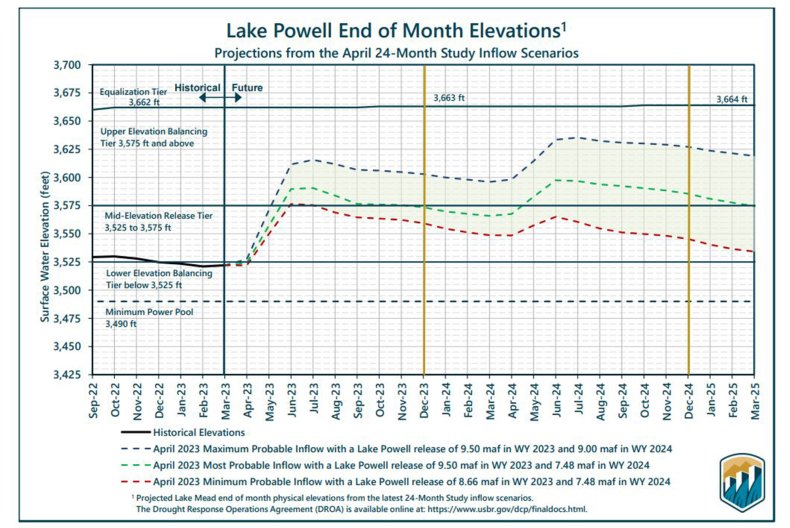Three Scenarios Predicted for Lake Powell Water Levels
Three possible scenarios have been mapped out for Lake Powell as the summer months approach.
Lake Powell's water levels could rise to 3,615.62 feet by the end of July, according to a 24-month report on maximum probable inflow released in April by the U.S. Bureau of Reclamation. This is the best-case scenario mapped out by the bureau.
Water levels at the reservoir, which sits on the Colorado River in Utah and Arizona, were at 3,530.67 feet as of Sunday. Another and more likely scenario forecasts that the reservoir will reach 3,590 feet by the end of July, slightly higher than its current level. At the end of July 2022, Lake Powell dipped to 3,535 feet.
The minimum possible water level that could be seen this summer is 3,575.44 feet, according to the Bureau of Reclamation's forecasting.
In February, Lake Powell's water level reached a low of 3,521.77 feet. This is the lowest level since the man-made lake was first filled in the 1960s, not long after its construction.

The low water levels are mainly a result of the severe drought that hit the Southwest, along with overconsumption of water in the Western states. Lake Powell began drying up after the drought started in 2000. But much of the West saw severe winter storms in recent months. This led to higher than average snowpack levels, which were not a factor during the dry period last year.
As this snowpack melts with seasonal warming, snowmelt will feed into Lake Powell and other reservoirs on the Colorado River like Lake Mead. The Bureau of Reclamation has already implemented initiatives to help manage the higher than average flows.
At the end of April, up to 39,500 cubic feet per second of water was released from the Glen Canyon Dam. This is much more than usual. The water ran through the Grand Canyon all the way into Lake Mead in an effort to replenish its water levels.

Lake Powell and Lake Mead are hugely important to the Southwest, as millions of people in the surrounding states rely on them for water. Lake Mead provides water to 25 million people living in the Colorado River Basin states.
Both reservoirs were formed by dams that generate hydropower for the surrounding areas.
Bureau of Reclamation officials are watching water levels closely to determine whether they need to implement initiatives to conserve water.
Do you have a tip on a science story that Newsweek should be covering? Do you have a question about drought? Let us know via science@newsweek.com.








